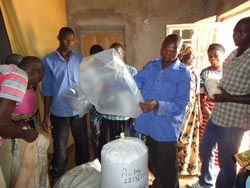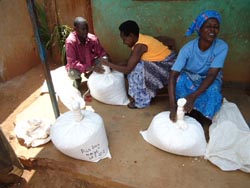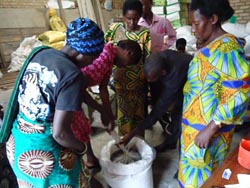Post harvest handling and storage of grains constitute a major challenge for farmers, especially in the rural areas of Rwanda. Especially insect pests cause major losses during grain storage. Farmers use several storing technologies but most of them are not effective, expensive or present health risks due to misuse or overuse of chemicals such as insecticides. Under the N2Africa context of linking farmers to markets, a study was initiated to assess the efficacy of the Purdue Improved Crop Storage (PICS bags), a triple layer hermetic bag developed by Purdue University. The bag was originally developed for storage of and controlling pests in cowpea, common bean, maize and sorghum. The grains can be stored for several months, which allows farmers to access better prices on the market. The advantage of PICS bags is that i) no pesticide is needed to store the grain, ii) the grain can be stored up to one year, and iii) the bag can be reused up to 4 years.
 |
 |
Left: Demonstration of PICS bags technology at Rwinkwavu action site in Kayonza district, March 2012 Right: Farmers with their pics bags after the demonstration session at Rukara action site, March 2012 |
Methodology
The pilot storage activities with PICS bags were conducted in three districts namely Kamonyi, Kayonza and Bugesera, representing areas where pest infestations are usually high due to favorable climatic conditions. The study was carried out in two consecutive periods, March to September 2012, and July 2012 to January 2013 using different farmers. In total, 82 pilot farmers with at least 30 kg stored the grain for 6 months (Table 1). Prior to bagging, grains were inspected for the prevalence of insects, and moisture content was measured. The study consisted of opening the bags every month for six months to monitor the attack of insects and moisture content inside the bag. After storage, a sample was taken from each bag for germination tests.
|
Period |
Crops |
Bugesera |
Kayonza |
Kamonyi |
Total number of bags stored* |
|||
|
Men |
Women |
Men |
Women |
Men |
Women |
|||
|
March–September 2012 |
Bean |
|
|
3 |
8 |
4 |
11 |
26 |
|
|
Maize |
|
|
9 |
9 |
1 |
1 |
20 |
|
|
Sub-total |
|
|
12 |
17 |
5 |
12 |
46 |
|
July 2012–January 2013 |
Bean |
8 |
8 |
6 |
9 |
2 |
15 |
46 |
|
|
Maize |
5 |
1 |
1 |
0 |
0 |
0 |
7 |
|
|
Sorghum |
1 |
1 |
0 |
1 |
0 |
0 |
3 |
|
|
Subtotal |
14 |
10 |
7 |
10 |
2 |
15 |
56 |
|
|
Total |
14 |
10 |
18 |
27 |
7 |
27 |
102 |
|
*Some pilot farmers stored more than one bag and or more than one crop |
||||||||
|
|
Farmers at Kamonyi inspecting bean grains for insect damage after opening the Pics bags closed for 6 months |
Results
Results show that PICS bags could be an alternative solution of storing grains for a longer period in a consumer friendly environment. In the first period, results from samples taken at the beginning of the experiment did not differ from the ones taken at the end. The incidence of insects varied between 0 and 4%, and germination rate ranged between 74 - 99%. The variation depended on the type of grain used but not the period kept in the triple bag, with the local mixture of bean having a lower germination rate compared to the improved varieties (RWR2245 and RWR 1668). Results from the second period confirmed what was observed in the first period. There was no infestation after closing the bags and the rate of insects’ incidence in the bags remained constant for the 6 months. The moisture content did not increase inside the bags, remaining in the range between 9.2 – 11.6% for beans, 10- 12.4% for maize and 9.1% for sorghum. As for the first season, results of the test confirmed what was observed in the first season, where the germination rate was above 75% for all types of grains.
Feedback from farmers who participated in the experiments
At the beginning of the study, farmers were hesitating to provide a significant amount of grain, fearing that their produce might be spoiled inside the plastic bags. However, after 1 month in of the study, farmers became convinced of the technology. Some farmers even put aside a small quantity of grain to compare if there was a difference in or outside the bag. After the third month, grains outside the bag were completely destroyed by insects. The question remaining was whether stored grains in the plastic would germinate. Results from the germination test persuaded them. We did not perform a cooking test, but farmers themselves informed us of the good culinary quality of the grains from the experiment. After the second period of the experiment, farmers who participated in the study and their neighbors started asking how to acquire these PICS bags and how much would they cost. When asked how much they would pay, it ranged from 1 to 3 USD. For those farmers, the local availability of the bags was more important than the price.
Way forward
The main objective of the study to explore the efficacy of PICS bags to store common bean grain for a period of at least 6 months from harvesting, for consumption as well as for seed, was met. The Ministry of Agriculture (MINAGRI) through its Post Harvest Handling and Storage Task Force has initiated a campaign to promote the hermetic bags for grain storage, mainly maize and common bean. A significant amount of PICS bags have been ordered from a local Ecoplastic company, to be distributed country wide by recognized agro-dealers at grass roots level (administrative sectors). The N2Africa FLO was called to demonstrate how the technology works, and a training session was organized twice, first for the agrodealers from the 30 districts of Rwanda, and secondly for districts technicians in charge of Post Harvest Handling and Storage. The technology was also promoted through several radio shows by the Deputy Director General for Extension, the Chairman of MINAGRI’s Post Harvest Handling & Storage Task Force, and the N2Africa Farm Liaison Officer. All the above events might promote the dissemination and the use of PICS bags technology in Rwanda.
Speciose Kantengwa, FLO Rwanda; Freddy Baijukya, country mentor, Rwanda

